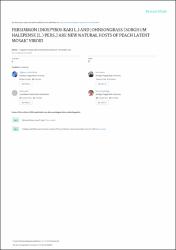| dc.contributor.author | Oksal, HD | |
| dc.contributor.author | Aydın, S | |
| dc.contributor.author | Baran, M | |
| dc.contributor.author | Emir, C | |
| dc.contributor.author | Karanfil, A | |
| dc.contributor.author | Bozdoğan, Olcay | |
| dc.contributor.author | Sipahioglu, HM | |
| dc.date.accessioned | 2022-03-09T08:31:10Z | |
| dc.date.available | 2022-03-09T08:31:10Z | |
| dc.date.issued | 2021 | en_US |
| dc.identifier.citation | Oksal, H. D., Aydin, S., Baran, M., Emir, C., KARANFIL, A., Bozdoğan, O., & Sipahioglu, H. M. (2021). Persimmon (Diospyros kaki l.) and johnsongrass [sorghum halepense (l.) pers.] are new natural hosts of peach latent mosaic viroid. Applied Ecology and Environmental Research, 19(6), 4629-4639. | en_US |
| dc.identifier.issn | 1589-1623 | en_US |
| dc.identifier.uri | https://hdl.handle.net/20.500.12899/563 | |
| dc.description.abstract | Peach latent mosaic viroid (PLMVd) naturally infects stone fruits worldwide. Here, we report the first detection of PLMVd in persimmon (Diospyros kaki L.) and a weed Johnsongrass [Sorghum halepense (L.) Pers.]. Samples corresponding to 12 persimmon specimens and weeds nearby the persimmon trees were collected from a germplasm collection plot in Malatya (Turkey). Total RNAs were isolated using a silica-based method and the complete viroid genome was amplified by reverse transcriptase polymerase chain reaction (RT-PCR). From these samples, PLMVd was detected in 7 of the 12 persimmons and in Johnsongrass revealing 8 new sequence variants. Multiple alignment and phylogenetic analyses revealed that identified persimmon and Johnsongrass isolates clustered only with PLMVd-walnut isolates previously identified from same locality. The nucleotide sequences of PLMVd persimmon and Johnsongrass isolates showed 96.71-99.11% similarity with the PLMVd isolates detected in different fruit crops in the world. A single specific mutation identified in two PLMVd persimmon variants (-TH2 and-TH10) effectively changed the predicted secondary structure of the agent. The identification and the genetic analyses of PLMVd variants in persimmon and Johnsongrass confirm that the agent is a ubiquitous and genetically variable viroid that infects cultivated fruit and weeds worldwide. | en_US |
| dc.language.iso | en | en_US |
| dc.publisher | CORVINUS UNIV BUDAPESTVILLANYI UT 29/43, BUDAPEST H-1118, HUNGARY | en_US |
| dc.rights | info:eu-repo/semantics/openAccess | en_US |
| dc.subject | PLMVd | en_US |
| dc.subject | RT-PCR | en_US |
| dc.subject | Turkey | en_US |
| dc.subject | weed | en_US |
| dc.subject | persimmon | en_US |
| dc.subject | identification | en_US |
| dc.title | PERSIMMON (DIOSPYROS KAKI L.) AND JOHNSONGRASS [SORGHUMHALEPENSE (L.) PERS.] ARE NEW NATURAL HOSTS OF PEACH LATENT MOSAIC VIROID | en_US |
| dc.type | Article | en_US |
| dc.department | MTÖ Üniversitesi, Ziraat Fakültesi, Bitki Koruma Bölümü | en_US |
| dc.identifier.volume | 19 | en_US |
| dc.identifier.issue | 6 | en_US |
| dc.identifier.startpage | 4629 | en_US |
| dc.identifier.endpage | 4639 | en_US |
| dc.relation.publicationcategory | Makale - Uluslararası Hakemli Dergi - Kurum Öğretim Elemanı | en_US |
| dc.identifier.scopusquality | Q3 | en_US |
| dc.identifier.wos | WOS:000725485200028 | en_US |
| dc.identifier.wosquality | Q4 | en_US |
| dc.indekslendigikaynak | Web of Science | en_US |
| dc.indekslendigikaynak | Scopus | en_US |


















